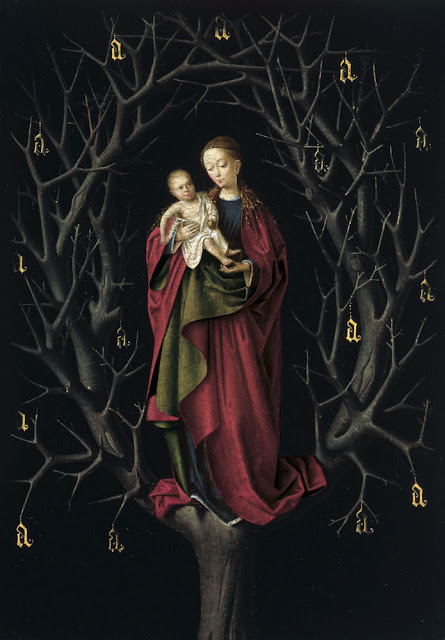 |
| Rogier van der Weyden Diptych of the Crucifixion with the Virgin and St John the Evangelist ca. 1463-64 oil on panel Philadelphia Museum of Art |
Rogier van der Weyden's Crucifixion Diptych (above) has had a troubled but active history at the hands of museum professionals – "The two panels, which clearly belong together, must also have been displayed side by side, as is evident in the way part of Mary's cloak continues onto the right wing ... It is erroneous to see the paintings as the exterior sides of two altarpiece wings or the scene with Christ as the central panel of a triptych. The red cloth behind the figures in each wing is pushed toward the division between the two panels. At the time of the 1941 restoration, which was based on an incorrect analysis of the painting, the uniform dark-blue, almost black sky was wrongly identified as an eighteenth-century overpainting of a gold background and replaced with gold (it was reapplied in 1992-1993 as a facsimile of the original, on top of the gold addition). The realistic details of the architecture, including the moss and the dripping moisture, were not considered original either and were duly removed, producing an archaic and abstracted painting with a gold background, with no naturalistic precision in the area surrounding the figures, and an unbalanced, disturbed relationship between the colors. All this has since been redressed."
– from The Flemish Primitves by Dirk de Vos (Princeton University Press, 2002)
 |
| Juan de Flandes Portrait of an Infanta (possibly Catherine of Aragon) ca. 1496 oil on panel Museo Thyssen Bornemisza, Madrid |
 |
| Juan de Flandes Lamentation ca. 1500 oil on panel Museo Thyssen-Bornemisza, Madrid |
 |
| Rogier van der Weyden Group of men ca. 1460 oil on panel Musées Royaux des Beaux-Arts, Brussels |
 |
| follower of Rogier van der Weyden Abegg Triptych ca. 1445 oil on panel Abegg Stiftung, Riggisberg |
 |
| Juan de Flandes Revenge of Herodias 1496 oil on panel Museum Mayer van den Bergh, Antwerp |
 |
| workshop of Rogier van der Weyden A Man Reading (possibly St Ivo) ca. 1450 oil on panel National Gallery, London |
"The fifteenth century is an age which saw the origin of the painting as an independent universe, of depiction as ersatz nature. ... The increasing autonomy of the painted image eventually manifested itself materially as well. A movable 'piece of wall furniture' was created, specially designed to contain a painted representation. It is the fifteenth-century painting now so familiar to us: a panel rendered mirror-smooth with filler and slotted into a frame like glass in a window, a kind of flat shadow-box which exerted the same visual magic no matter which wall it was affixed to or which space it occupied."
– from The Flemish Primitves by Dirk de Vos (Princeton University Press, 2002)
 |
| Jan van Eyck Annunciation Diptych ca. 1433-35 oil on panel Museo Thyssen Bornemisza, Madrid |
 |
| Petrus Christus Virgin of the Dry Tree ca. 1465 oil on panel Museo Thyssen Bornemisza, Madrid |
 |
| Rogier van der Weyden Portrait of a woman in winged headdress ca. 1445 oil on panel Staatliche Museen, Berlin |
 |
| Rogier van der Weyden Virgin and Child Enthroned ca. 1433 oil on panel Museo Thyssen-Bornemisza, Madrid |
 |
| Rogier van der Weyden Portrait of a woman ca. 1455 oil on panel National Gallery of Art, Washington DC |
 |
| Rogier van der Weyden Portrait of Francesco d'Este ca. 1460 oil on panel Metropolitan Museum of Art, New York |
 |
| Rogier van der Weyden Madonna and Child after 1454 oil on panel Museum of Fine Arts, Houston |